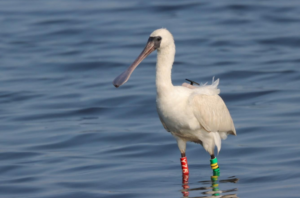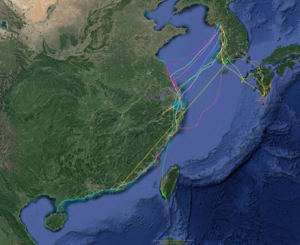EAAFP Small Grant Fund Project by
Chi Yeung Choi, Jimmy
Duke Kunshan University

The individually-marked Black-faced Spoonbill ‘Y75’, was one of the twenty individuals tagged with satellite tracker. Y75 was ringed on Chilsando, Korea, 2nd July 2020, then seen on Taiwan Island 26th October 2020 ©Yi-Cheng Chen
Among the threatened migratory waterbird species in the East Asian–Australasian Flyway (EAAF), the Black-faced Spoonbills (BFS) Platalea minor stands out as one of the very few species showing a recovering trend, from just a few hundred to more than 6,000 over the last 30 years partly due to the extensive conservation effort and BFSs’ ability to utilise artificial wetlands. Over the years, the foraging ecology (Yu et al. 2004a), habitat use (Yu et al. 2004b), threats (Sung et al. 2018) and migration routes (Wood et al. 2013) of BFS have been studied in various locations. Yet relatively little is known about their movement ecology, especially juveniles.
In this proposed project, we aim to quantify the wintering distribution pattern of juvenile BFS in their first boreal winter using GPS-GSM transmitters. The ultimate goal is to identify the key regions where juvenile BFS winter and safeguard these areas for the continuous recovery of this endangered population.
In 2020 June and July, juvenile BFS were captured near their nests from breeding islands along the west coast of South Korea. Measurements were recorded and unique colour ring combination on the tibia of BFS was used for individual marking. Solar-powered GPS/GSM satellite trackers (19g or 1.3% of juvenile BFS body weight) were deployed to the back of spoonbills using backpack method.
Twenty juvenile BFS were captured and equipped with satellite trackers on their back during June and July 2020. Five individuals died without leaving Korea while one individual with tracker failure. In the remaining 14 individuals that left Korea and migrated, 10 of them (71.4%) spent their first winter in mainland China, two (14.3%) on Taiwan Island and two (14.3%) in southeast Japan. Among the 10 individuals that spent their first winter in mainland China, three individuals (30%) stayed in Jiangsu province and another three individuals (30%) in Zhejiang province, while two individuals (20%) resided in Guangdong, one individual in Hainan and one in Anhui. About half of these 14 wintering sites were protected. Among the 14 individuals that left Korea, the one that spent its first winter at the highest latitude (Jiangsu Lianyungang) and the one at the lowest latitude (Hainan) eventually died during their first winter.
Our results showed the importance of the coastal wetlands in mainland China, especially those along the Jiangsu, Shanghai and Zhejiang coasts, for juvenile BFS during their southward migration and first winter. All tracked individuals that flew across the Yellow Sea from the west coast of Korea made their first landfall in coastal wetlands along the Jiangsu, Shanghai and Zhejiang coasts.
The tracking results indicated the importance of coastal wetlands in Zhejiang Zhoushan, Hangzhou Bay and Wenzhou Bay to juvenile BFS. Moreover, two of the tracked birds that migrated successfully to mainland China for their first winter, eventually died at Lianyungang and Hainan. The cause of mortality was unclear but 35% of tracked BFS died within 6 months after released, showing the challenges that young BFS faced in their early years. It is important to record the potential cause of mortality and mitigate those threats to ensure the continuous population recovery of this endangered species.
This project laid the important foundation for further tracking projects that will help researchers to determine the potential drivers for the observed juvenile wintering distribution pattern. This could be achieved by combining the tracking data with findings with annual synchronized censuses. Moreover, the tracking data could also be used to evaluate the extent to which protected areas along the flyway encompass the full range of habitats used by BFS during non-breeding season.

The southward migration pathway and wintering distribution of satellite-tracked Black-faced Spoonbills in 2020
References:
Sung Y-H, Tse IW-L, & Yu Y-T. 2018. Population trends of the Black-faced Spoonbill Platalea minor: analysis of data from international synchronised censuses. Bird Conservation International, 28(1), 157-167.
Wood, C., Tomida, H., Jin-Han, K., Lee, K.S., Cho, H.J., Nishida, S., Ibrahim, J., Hur, W.H., Kim,
Yu YT, & Swennen C. 2004a. Feeding of wintering Black-faced Spoonbills in Hong Kong: When and how long? Waterbirds, 27(2), 135-140.
Yu YT, & Swennen C. 2004b. Habitat use of the Black-faced Spoonbill. Waterbirds, 27(2), 129-134.
The project was funded through the 2020 EAAFP WG/TF Small Grant Fund. View the report, Click here.





